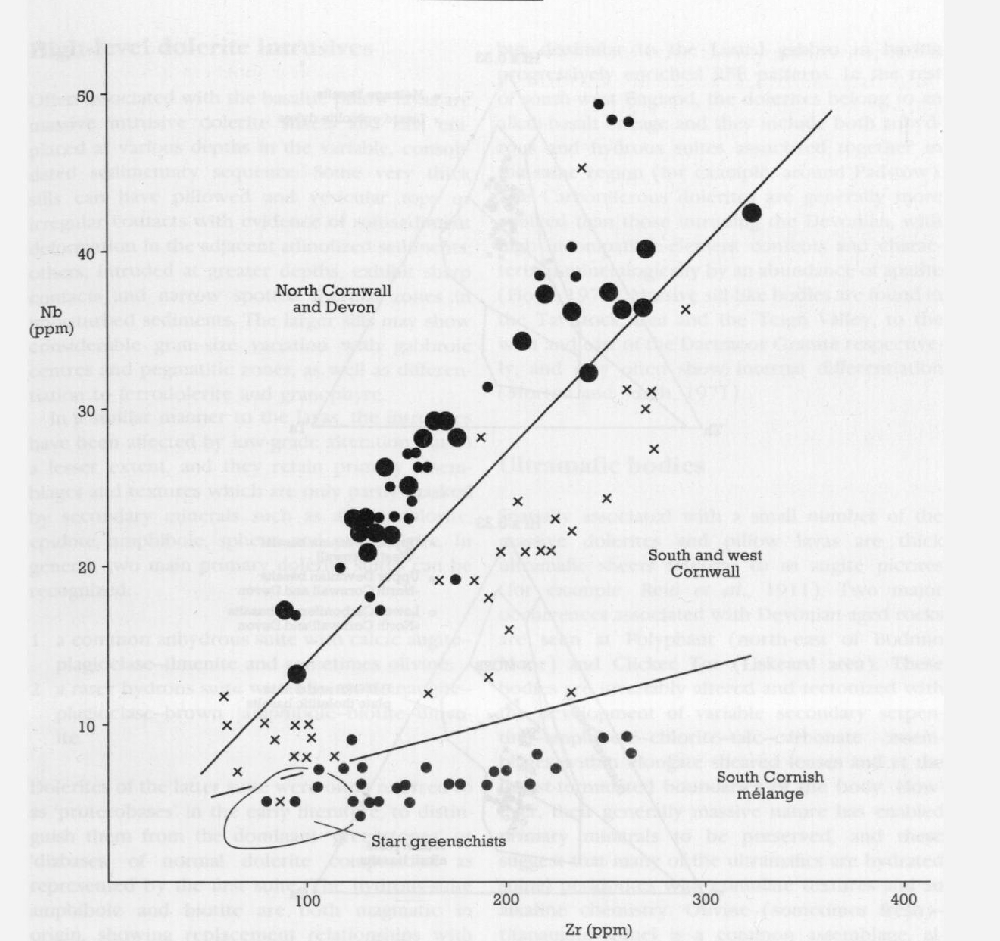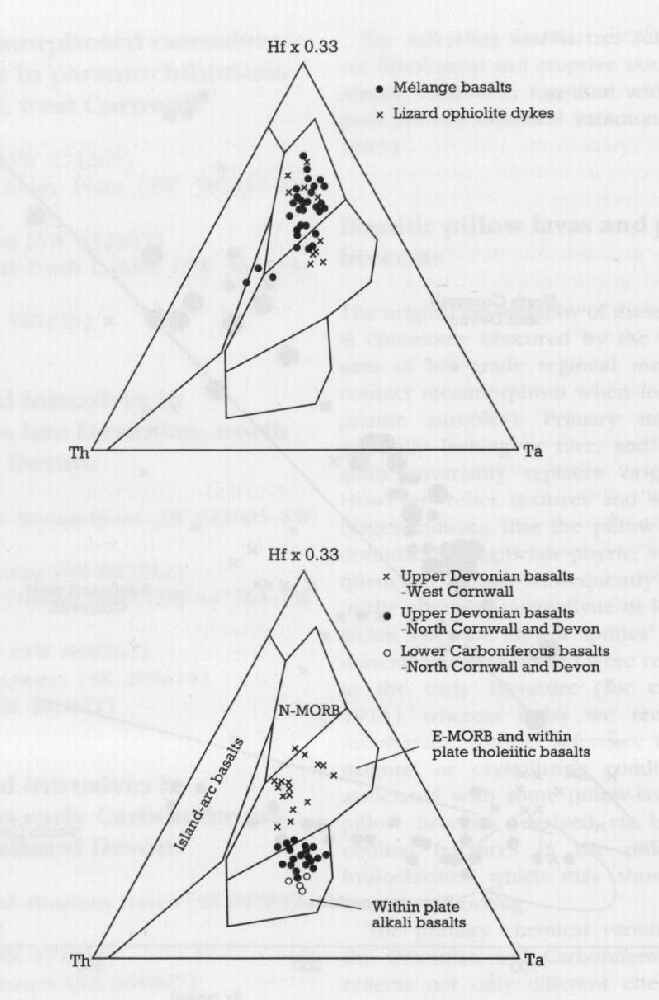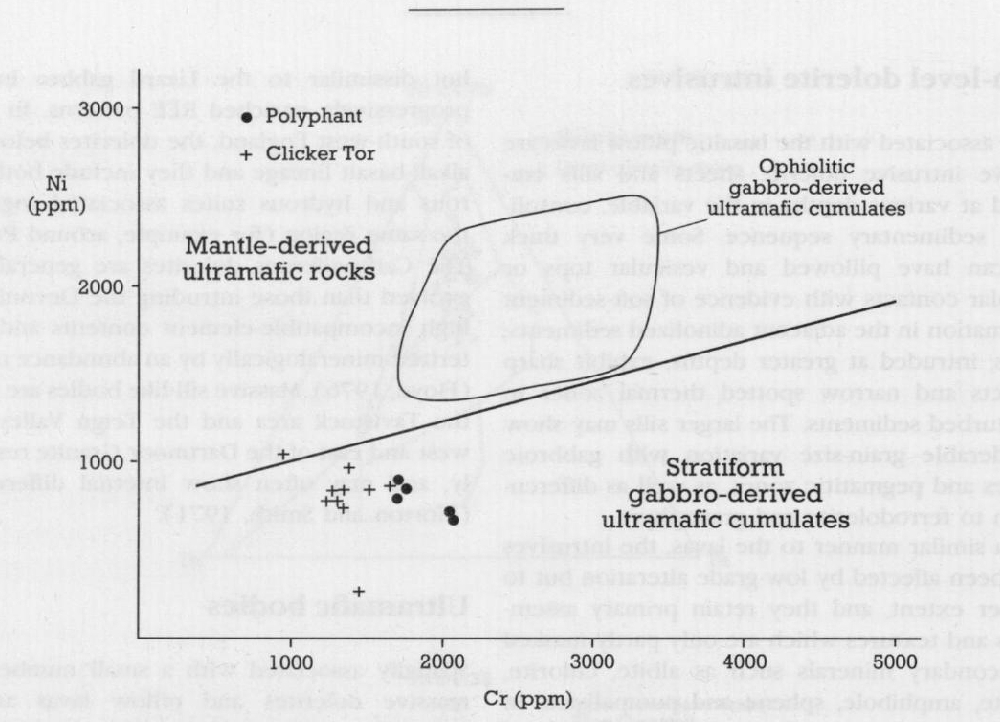Chapter 4 Pre-orogenic volcanics (Group B sites)
Introduction
The sites covered in this chapter are listed below, and arranged in broad stratigraphic–tectonic groups from west Cornwall to east Devon. The majority are examples of extrusive and intrusive basaltic rocks covering the late Devonian–early Carboniferous period of maximum volcanic activity in south-west England. The actual intrusion age of the large sills is not known, although many in western Cornwall appear to be pre-main-phase deformation, that is, pre-late Devonian (Taylor and Wilson, 1975). Other bodies showing evidence of high-level intrusion, soft-sediment deformation and spatially associated lavas, have an age corresponding with the enclosing sediments. In central south-west England, where faunal evidence of depositional age is good, lavas interbedded with dated sediments are typically Frasnian (for example, Pentire Point pillow lavas), Famen-nian (for example, Chipley pillow lavas) or Dinantian (for example, Tintagel Volcanic Formation). Lavas within the poorly fossiliferous Mylor Slate and Gramscatho Formations of western and southern Cornwall are probably late Devonian (Turner et al., 1979; Wilkinson and Knight, 1989).
Both the magmatic and superimposed contact-metamorphic features of late Devonian extrusives and closely associated intrusives within the Land's End Granite aureole are described, as these sites often exhibit classic contact effects of high-level granites.
The locations of all sites are shown in
List of sites
Intrusives in parautochthonous late Devonian, west Cornwall:
B1 Porthleven
B2 Cudden Point–Prussia Cove
Contact-metamorphosed extrusives and intrusives in parautochthonous late Devonian, west Cornwall:
B3 Penlee Point
B4 Carrick Du–Clodgy Point
B5 Gurnard's Head
B6 Botallack Head–Porth Ledden
B7 Tater-du
Extrusives and intrusives in allochthonous late Devonian, north Cornwall and Devon:
138 Pentire Point–Rumps Point
B9 Chipley Quarries
B10 Dinas Head–Trevose Head
B11 Trevone Bay
B12 Clicker Tor Quarry
B13 Polyphant
Extrusives and intrusives in allochthonous early Carboniferous, north Cornwall and Devon:
B14 Tintagel Head–Bossiney Haven
B15 Brent Tor
B16 Greystone Quarry
B17 Pitts Cleave Quarry
B18 Trusham Quarry
B19 Ryecroft Quarry
Lithological and chemical variation
All the Devonian and early Carboniferous volcanics in Cornwall and Devon appear to be submarine in origin, with water depth varying from relatively shallow (reef/platform environment) to deep (basin and basin/slope margin environment). Although dominated by basaltic material, the volcanics represent a bimodal basic–acid suite comprising lavas, high-level intrusives and abundant volcaniclastics, often in close stratigraphical association.
The following summarizes some of the different lithological and eruptive associations that are readily identified, together with an outline of their primary chemical variation (see also Floyd, 1983).
Basaltic pillow lavas and pillow breccias
The original petrography of these submarine lavas is commonly obscured by the secondary products of low-grade regional metamorphism (or contact metamorphism when located within the granite aureoles). Primary mafic phases are generally lacking or rare, and low-temperature albite invariably replaces original plagioclase. However, relict textures and secondary assemblages indicate that the pillow lavas were predominantly plagioclase-phyric, variably vesicular, quenched basalts subsequently metamorphosed in the prehnite–pumpellyite or lower greenschist facies. They are typical 'spilites' in terms of their mineral assemblages and were referred to as such in the early literature (for example, Dewey, 1914), whereas today we recognize them as metabasalts, without reference to special spilitic magmas or crystallizing conditions. Intimately associated with some pillow-lava sequences are pillow breccias (derived via brecciation along cooling fractures in the pillows) and rarer hyaloclastites which may show the effects of current reworking.
The primary chemical variation displayed by the Devonian and Carboniferous basaltic lavas reflects not only different chemical suites and magma types, but can be related to broad tectonic units. This can be illustrated with reference to late Devonian pillow lavas developed within basinal sequences throughout south-west England. As seen in
As seen in a chemical-based, tectonic environment, discrimination diagram
Rhyolitic lavas
Owing to their variably altered and sheared nature these acidic lavas were often referred to as (quartz)-keratophyres or 'felsites' in the earlier literature (for example, Ussher, 1904). However, they retain relict textures and an observed (or inferred) primary mineralogy that clearly suggest that they were quenched rhyolitic or rhyodacitic flows.
Early acidic flows (early Devonian) in south Devon were nodular, quartz–alkali-feldspar-phyric rhyolites with a spherulitic quenched matrix, and they crystallized close to the ternary eutectic of the wet granite system (Durrance, 1985a). They are highly siliceous, with high K, Rb and Th, but chemically distinct from the Cornubian granites, granite porphyries and Permian rhyolites. Determination of their possible tectonic setting using chemical data suggests an active margin environment (Durrance, 1985a).
High-level dolerite intrusives
Often associated with the basaltic pillow lavas are massive intrusive dolerite sheets and sills emplaced at various depths in the variable, consolidated sedimentary sequence. Some very thick sills can have pillowed and vesicular tops or irregular contacts with evidence of soft-sediment deformation in the adjacent adinolized sediments; others, intruded at greater depths, exhibit sharp contacts and narrow spotted thermal zones in undisturbed sediments. The larger sills may show considerable grain-size variation with gabbroic centres and pegmatitic zones, as well as differentiation to ferrodolerite and granophyre.
In a similar manner to the lavas, the intrusives have been affected by low-grade alteration but to a lesser extent, and they retain primary assemblages and textures which are only partly masked by secondary minerals such as albite, chlorite, epidote, amphibole, sphene and pumpellyite. In general, two main primary dolerite suites can be recognized:
1. a common anhydrous suite with calcic augite–plagioclase–ilmenite and sometimes olivine;
2. a rarer hydrous suite with olivine–titanaugite–plagioclase–brown amphibole–biotite–ilmenite.
Dolerites of the latter suite were often referred to as 'proterobases' in the early literature, to distinguish them from the dominant 'greenstones' or 'diabases' of normal dolerite composition as represented by the first suite. The hydrous-suite amphibole and biotite are both magmatic in origin, showing replacement relationships with the pyroxene, and are characterized by being highly titaniferous (Floyd and Rowbotham, 1982).
To some extent the intrusives show a similar chemical polarization between south and west Cornwall relative to north Cornwall and Devon, as is seen in the lavas. However, the lavas and intrusives in the two regions also may not be directly related either spatially (the intrusives are not necessarily the deep-seated equivalents of the lavas) or genetically (via a magmatic process such as crystal fractionation) (Floyd, 1983). The dolerites/gabbros of south Cornwall are generally isolated, massive, differentiated tholeiitic bodies with olivine–pyroxene cumulates (Floyd and Al-Samman, 1980). They are relatively primitive chemically, with low Zr/Y and high Zr/Nb ratios, but dissimilar to the Lizard gabbro in having progressively enriched REE patterns. In the rest of south-west England, the dolerites belong to an alkali-basalt lineage and they include both anhydrous and hydrous suites associated together in the same region (for example, around Padstow). The Carboniferous dolerites are generally more evolved than those intruding the Devonian, with high incompatible-element contents and characterized mineralogically by an abundance of apatite (Floyd, 1976). Massive sill-like bodies are found in the Tavistock area and the Teign Valley, to the west and east of the Dartmoor Granite respectively, and may often show internal differentiation (Morton and Smith, 1971).
Ultramafic bodies
Spatially associated with a small number of the massive dolerites and pillow lavas are thick ultramafic sheets referred to as augite picrites (for example, Reid et al., 1911). Two major occurrences associated with Devonian-aged rocks are seen at Polyphant (north-east of Bodmin Moor) and Clicker Tor (Liskeard area). These bodies are invariably altered and tectonized with the development of variable secondary serpentine–amphibole–chlorite–talc–carbonate assemblages within elongate sheared lenses and at the thrust-terminated boundaries of the body. However, their generally massive nature has enabled primary minerals to be preserved, and these suggest that many of the ultramafics are hydrated spinel peridotites with cumulate textures and an alkaline chemistry. Olivine (sometimes fresh)–titanaugite–spinel is a common assemblage, although brown amphibole and biotite may also be present, suggesting a petrological link with the hydrous dolerite suite. No modern mineral or chemical analytical techniques have been applied to these rocks, so the actual compositions, of the phases are unknown relative to the dolerites. Equally, little is known about their bulk-rock chemistry, although (as seen in
Volcaniclastic rocks
Largely due to poor outcrop and the high degree of alteration exhibited, little modern volcanological work has been attempted on the tuffaceous volcaniclastic horizons. In general both acid and basic tuffs ('keratophyrici and 'spilitic', respectively, in previous accounts) are common, with an admixture of lithic clasts, altered glass, broken crystals and pumiceous lava fragments. Coarser-grained volcaniclastics could be represented by part of the early Carboniferous




